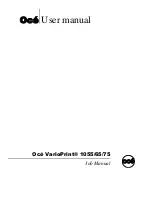
CHAPTER 8
HANDLING METHOD
8.1 INSTALLING/UNINSTALLING THE THERMAL PAPER
8.1.1 Procedures for Installing/Uninstalling the Thermal Paper
(1) Procedures for installing the thermal paper by the easy operation (setting and releasing the platen block)
(a) Installing the thermal paper
Install the thermal paper with the paten unit released.
Set the thermal paper straight to the printer and set the thermal paper until its edge is ejected for
5 cm and more from the top surface of the printer mechanism.
(b) Uninstall the thermal paper
Uninstall the thermal paper in the same manner for installing the thermal paper.
(c) Clearing a paper jam
Uninstall the thermal the paper in the same manner for installing the thermal paper.
(2) Procedures for installing the thermal paper by auto-loading function
(automatic insertion when the platen block is in set status)
(a) Procedures for Installing the Thermal Paper
Well-cut the thermal paper edge with scissors and cutter knife. Cutting the thermal paper edge
perpendicular to paper feed direction, shown in Figure 8-1.
Figure 8-1 Shape of the Thermal Paper Edge
8-1



































